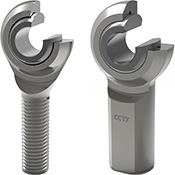Rod ends – sometimes referred to as spherical rod end bearings – are precision articulating joints. They are found in tie rods and steering links or anywhere a misaligned motion connection is necessary. Comprised of a ball, housing and shaft, angular variances are managed by the interaction between the ball and housing.
When selecting a rod end manufacturer for either a commodity or custom rod end, find the right partner by verifying the following:
- Manufacturing certification
- Raw material selection
- Production process
- Heat treatment
- Testing facilities
- Logistics
Types of Rod Ends
Rod end manufacturers can produce a number of rod end bearing styles. They include:
- Internal thread (female)
- External thread (male)
- Self-lubricating/Metal-to Polymer
- Metal-to-metal with grease fitting
- Extended inner ring
- Ball joint rod ends
Rod End Super Finishes
Corrosion resistance is vital to rod ends as they work in exposed areas under rough environmental conditions. Your rod end bearing manufacturer may offer the zinc finish to prevent rust.
Certification for a Rod End Manufacturer
When choosing a rod end manufacturer, look for ISO 9001 and TS 16949. Both of these certification programs verify that the manufacturer has a series of processes that are strictly followed to provide consistent products. These quality management systems are designed to emphasize continual improvement, defect prevention and the reduction of waste.
TS 16949 is specific to the automotive industry
ISO 9001 branches across industries
Custom Rod Ends
Designing a Custom Rod End
With the different surface coatings, lubrication options and designs, custom rod ends are available. It is important to work with a rod end manufacturer who can lend engineering support to your design – and at the beginning of the project.
CCTY has a developed a bearing design checklist that can guide you through the process. Download your copy here.
Rod End FAQs
What is the purpose of a rod end bearing?
A rod end is an articulating joint that is usually found where misalignment occurs. For example, they are used in tie rods, steering links and control rods. A rod end provides precise control with point-to-point contact from the rotation’s center on the axis of attached shafts.
How do self-lubricating rod ends differ from metal-to-metal rod ends?
Self-lubricating – or metal-to-polymer – rod ends do not require maintenance. They are formulated with lubricants that last the life of the bearing and may take the form of a bushing, nylon or PTFE. Metal-to-metal rod ends require periodic regreasing, so the rod ends are manufactured with a zerk.
What is a zerk?
A zerk is a grease fitting that allows lubricant to enter the bearing. Using high pressure, a grease gun is used to push the lubricant into the bearing through the zerk.
What is the benefit of self-lubricating rod ends?
Self-lubricating rod ends eliminate the need to re-grease bearings. By using PTFE or nylon, the rod end is greased for life, so there is no ongoing maintenance required.
When do you need to replace a rod end?
Replace the rod end if you can feel excessive play or there is excessive noise in the application. Rod ends can be optimized to meet application requirements without wearing out.
What type of material is used in rod ends?
- Aluminum
- Steel
- Stainless steel
- High-carbon steel

